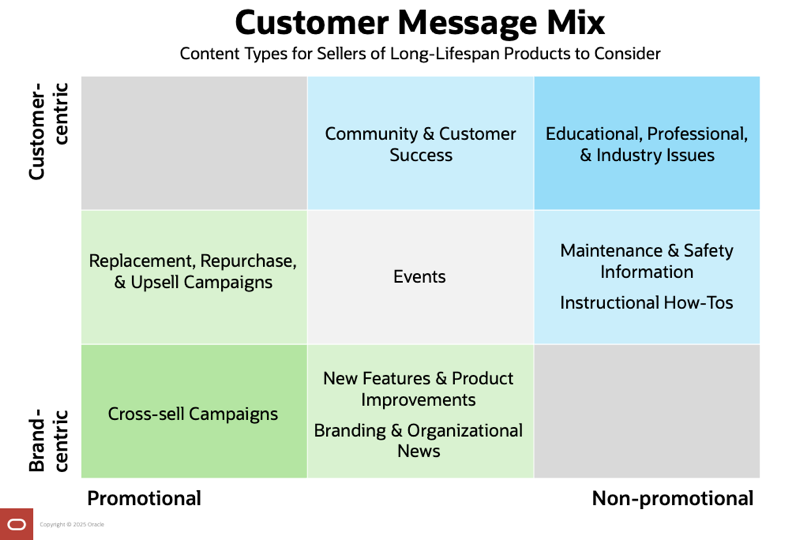A version of this post was originally published on MarketingProfs.com.
For B2B and B2C brands that sell products with lifespans that stretch into multiple years like machinery and cars, devising a digital marketing content strategy can be difficult. They know they need to keep their customers engaged, but they often struggle with how to keep the conversation and relationship going between product replacement cycles.
For permission-based channels like email and SMS, it can be dangerous to not reach out to subscribers on at least a monthly basis. Less frequent messaging can zero out your email sender reputation, for instance. More broadly—and perhaps counterintuitively—it can be much, much harder to maintain permission when you message, say, every other month than twice a month, because you’re easier to forget. Plus, when your customer is back in the market to buy again, you want your brand to be top of mind.
Given those realities and those needs, brands need to have messaging frequencies of at least once a month, if not more frequent. But then there’s the struggle about what kind of content to send that acknowledges and respects long product replacement cycles.
What Should Brands Message Their Customers about?
Consider a mix of content from these nine topic areas, which range from non-promotional to promotional, and from customer-centric to brand-centric.

In general, brands that sell long-lifespan products should favor a heavier mix of customer-centric and non-promotional content.
1. Maintenance & Safety Information
The first step in keeping a customer engaged is ensuring they get the most possible out of their existing purchase, so let’s start there. Through an automated post-purchase series or personalized content in a newsletter or other broadcast campaign, help your customers understand how to use their existing purchase safely and take care of it. Consider content such as:
- How to use the product properly and safely, including hazards to watch out for
- How to care for the product, including dos and don’ts
- Promoting apps or app features that help with maintenance
- How to get customer support and response center assistance
- Announcements of product recalls
- When professional care may be needed and how often
- Frequently asked questions about maintenance and safety
Related post: Picking the Right Sender Name: Brand or Person?
2. Instructional How-Tos
Beyond safety, help your customers get more productivity and efficiency out of their existing purchase. Consider content such as:
- How to use various product features, including your most popular features and highlighting little-used and niche features
- How to configure the product to work best for individual customers, depending on their goals, environment, industry, etc.
- How your product works with other products the buyer may own
- Explaining how product usage can change over time, such as the buyer’s company growing in size or the user becoming more skilled or stronger
- Covering compliance with international, national, and state regulations
Related post: Email Newsletters: The New Best Practices
3. New Features & Product Improvements
Especially in the software and consumer electronics industries, many existing products are updated over time. Make sure your customers are aware of these improvements, bug fixes, and new product features that they can take advantage of for free as existing customers. Consider content such as:
- Announcements of new features, updates, and patches
- Announcements of website and app enhancements
- Announcements of infrastructure improvements that affect product performance, customer support, etc.
- Announcements of new partnerships that affect cross-compatibility with other products and services, ease of integration, etc.
4. Educational Professional, & Industry Issues
To be successful, your customers need to know more than just how to use your product. They need to understand the issues surrounding your product, whether those are about health, sports, their industry, their profession, or something else. Consider content such as:
- Explanations of and commentary about relevant news
- Discussions of trends, best practices, and the future
- Collaborations and interviews with experts, superfans, celebrities, etc.
Related checklist: ~1,000 Content Calendar Messaging Ideas
5. Community & Customer Success
This is the voice of your customer, whether it’s a forum where customers talk to each other, your social media channels, or customer stories that are given voice by your PR and marketing teams. Consider content such as:
- Customer forum topics
- User-generated content
- User/customer surveys
- Testimonials, product reviews, etc.
- Customer spotlights or success stories
- Customer award programs
Related post: Writing Survey & Progressive Profiling Questions that Deliver Valuable Insights
6. Branding & Organizational News
This is the voice of your brand. It’s generally best to be heavily biased toward talking about your customers and your industry, but your customers do care about what you’re doing, because they care about their association with you. Consider content such as:
- Announcements of news, accolades, award wins, etc.
- Celebrations of milestones, such as customer counts, monthly active user counts, products sold, content library size, funding rounds, and going public
- Announcements of acquisitions, new partnerships, etc.
7. Events
While live and virtual events are mostly a medium for all the content types we’ve discussed so far (plus the remaining two to a lesser degree), they’re also a content type in and of themselves. Especially for live events, the experience and everyone’s reaction to it becomes content. Consider content such as:
- A summary of key sessions, performances, or demonstrations, including with a focus on themes
- A spotlight on the most popular or favorite event moments, according to attendance, attendee feedback, experts, etc.
- Viral or fun moments, whether from speakers/performers, attendees, or sponsors
- Photos from the event, both by organizers and attendees
Thus far, we’ve been talking about content that’s largely non-promotional and geared toward customer satisfaction and customer engagement. But, of course, promotional content is also important, especially since it can be difficult to know when a customer is going to be back in the market to buy. Sometimes, it’s much faster than you expect. Other times, it’s not.
8. Replacement, Repurchase, & Upsell Campaigns
A satisfied customer will likely be open to purchasing again or upgrading, so use lead scoring and other signs of growing interest to identify engaged customers who would be receptive. Then use customer success content and promotional content to look for more definitive signals of buying intent. Consider content such as:
- Financing, insurance, leasing, and other information that may be critical to a customer becoming ready to purchase again
- Highlighting key product features and value propositions, particularly those that the customer currently can’t take advantage of with their existing product
- Doing feature comparisons across your line of products so customers can understand the key differences
- Spotlighting key differentiators between your products and those of your competitors
While replacement cycles can be fairly predictable, especially if you are involved in the regular servicing of the purchased product, repurchases are less predictable. That’s because a B2B customer could at any time hire additional people, open additional facilities, or otherwise add capacity or want to boost productivity. And a B2C customer could similarly have growing needs, either for their personal use or other family members.
Related post (with on-demand webinar): Evolving Your Account-Based Marketing Program
9. Cross-sell Campaigns
Customer behavior and lead scoring can also identify those who would be receptive to cross-sell messaging. Consider content such as:
- Accessories and services directly related to already-owned products
- Products and services tangentially related to already-owned products
- Products and services unrelated to already-owned products (this being the toughest sell)
Related checklist: 170+ Segmentation & Personalization Ideas to Explore
The Right Messaging Mix
As you can see, brands have lots of potential content they could create and share with their customers. Having a solid mix of this content and then letting your customers’ engagement drive personalization, segmentation, and automation helps you meet your customers where they are in the buying cycle.
Special thanks to Kaitlin Reno, Jessica Stamer, and Peggy Sehorn for their contributions to this post.
—————
Need help with your digital marketing program? Oracle Digital Experience Agency has hundreds of marketing and communication experts ready to help Responsys, Eloqua, Unity, and other Oracle customers create stronger connections with their customers and employees—even if they’re not using an Oracle platform as the foundation of that experience. With a 94% satisfaction rate, our clients are thrilled with the award-winning work our creative, strategy, and other specialists do for them, giving us an outstanding NPS of 82.
For help overcoming your challenges or seizing your opportunities, talk to your Oracle account manager, visit us online, or email us at OracleAgency_US@Oracle.com.
To stay up to date on customer experience best practices and news, subscribe to Oracle Digital Experience Agency’s award-winning, twice-monthly newsletter. View archive and subscribe →
